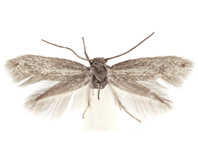Abstract
Males of most species of crickets and katydids produce species-specific calling songs to attract conspecific females. The typical stridulatory apparatus of the Ensifera consists of a file-and-scraper system in the basal dorsal region of the forewings (tegmina): the file on the underside of the cubital vein of one tegmen is composed of a series of lamelliform teeth and is run against the sclerotized scraper at the edge of the other tegmen. The region directly distal of the cubital vein is often thin and glassy and serves to amplify and spread the sound. In stridulating crickets the tegmina are quite symmetrical with both the left and the right one containing a file, which is considered the ancestral condition (Béthoux 2012). Most of these crickets adopted a right-over-left wing overlap and use only the right file. The few extant species of the ancient group Hagloidea have bilaterally symmetrical tegmina, both with functional files, and individual males can change the overlap (Morris & Gwynne 1978). Katydids are distinguished by a left-over-right wing overlap, with a stridulatory file on the underside of the left tegmen, and a scraper on the right one, which usually is also equipped with a mirror as resonating structure.

